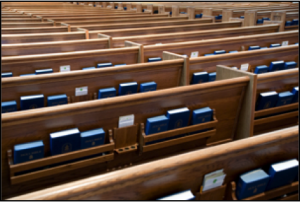 By: Paul L. Jones, CPA
By: Paul L. Jones, CPA
LEED Green Associate
Director, Financial Advisory Services for Emerald Skyline Corporation
“Climate change is the most serious issue facing humanity today. It is already seriously impacting economies, ecosystems, and people worldwide. Left unchecked, it will cause tremendous suffering for all living beings.” From the International Dharma Teachers’ Statement on Climate Change, 1/8/2014
“Because creation was entrusted to human stewardship, the natural world is not just a resource to be exploited but also a reality to be respected and even reverenced as a gift and trust from God. It is the task of human beings to care for, preserve and cultivate the treasures of creation.” Saint Pope John Paul II, The Church in Oceania, 2001, n.31
“For the Church of the 21st Century, good ecology is not an optional extra, but a matter of justice. It is therefore central to what it means to be a Christian.” Dr. Rowan Williams, Archbishop of Canterbury, Church Care, Church of England
“We are convinced that there can be no sincere and enduring resolution to the challenge of the ecological crisis and climate change unless the response is concerted and collective, unless the responsibility is shared and accountable, unless we give priority to solidarity and service.” From the Joint message from Pope Francis and Ecumenical Patriarch Bartholomew on the World Day of Prayer for Creation, September 1, 2017
‘Ecology’ (from the Greek oikos) refers to the Earth as our home; our place of wellbeing. For Christians, ecological stewardship is the conviction that every gift of nature and grace comes from God and that the human person is not the absolute owner of his or her gifts or possessions but rather the trustee or steward of them. These gifts are given in trust for the building of the Kingdom of God. Christians are called to appreciate the spiritual and theological significance of the Earth and to exercise ecological stewardship of the Earth and its resources. The gifts of creation are not simply there for human use, but have their own dignity, value and integrity.
In April 2016, Muslim leaders delivered the Islamic climate change declaration. From an article announcing its’ release, “Islam teaches us that ‘man is simply a steward holding whatever is on earth in trust’,” says Nana Firman, Co-Chair of the Global Muslim Climate Network. “The Declaration calls upon all nations and their leaders to drastically reduce their greenhouse gas emissions and support vulnerable communities, both in addressing the impacts of climate change and in harnessing renewable energy.”
“Mahatma Gandhi urged, ‘You must be the change you wish to see in the world.’ If alive today, he would call upon Hindus to set the example, to change our lifestyle, to simplify our needs and restrain our desires. As one sixth of the human family, Hindus can have a tremendous impact. We can and should take the lead in Earth-friendly living, personal frugality, lower power consumption, alternative energy, sustainable food production and vegetarianism, as well as in evolving technologies that positively address our shared plight.” From the Hindu Declaration on Climate Change
“In the Jewish liturgy there is a prayer called Aleinu in which we ask that the world be soon perfected under the sovereignty of God (le-takein ‘olam be-malkhut Shaddai). Tikkun ‘olam, the perfecting or the repairing of the world, has become a major theme in modern Jewish social justice theology. It is usually expressed as an activity, which must be done by humans in partnership with God. It is an important concept in light of the task ahead in environmentalism. In our ignorance and our greed, we have damaged the world and silenced many of the voices of the choir of Creation. Now we must fix it. There is no one else to repair it but us.” by Rabbi Lawrence Troster
So, all of the world’s major religions and all of the spiritual leaders of the world agree: Being a faithful steward in the care of His Creation is a religious and spiritual mandate: It is our obligation. But then we see churches that run the air conditioning full blast – when only a few people are present or we witness waste in water consumption, food preparation and other church, school and ecological waste in related parish activities. I think this lack of prioritization among every pastor, priest, rabbi, imam, swami and teacher, not just the leadership of a few, as evidenced by the failure to make every building occupied by a religious or spiritual institution sustainable.
As Saint James tells us “Who is wise and understanding among you? By his good conduct let him show his works in the meekness of Wisdom.” (James 3:13)
Hartford Institute estimates there are roughly 350,000 religious congregations in the United States. This estimate relies on the RCMS 2010 religious congregations census. Of those, about 314,000 are Protestant and other Christian churches, and 24,000 are Catholic and Orthodox churches. Non-Christian religious congregations are estimated at about 12,000.
According to the Catholic Climate Covenant in their presentation on the Catholic Covenant Energies program, “there are an estimated 70,000 Catholic-owned buildings in the United States.” Considering that the Catholic Church represents less than 10% of all religious congregations in the U.S., the opportunity for reducing the carbon footprint through sustainable practices in our churches, synagogues, mosques, schools, day care centers and other facilities operated by religious congregations is enormous. The Covenant calculates that by implementing proven and affordable conservation measures, Catholic-owned buildings can reduce energy use in buildings owned by 25% saving the Catholic Church $630 million in energy costs, “reducing energy use by an equivalent of 8.7 million tons of coal.”
Now, imagine if all faith denominations practiced what they preached – and not just in the United States but throughout the world! The Church and all religious denominations would then make a real – and positive – impact on the lives of all people, reducing suffering and promoting the cause of social justice. Further, the savings from lower utility bills and other sustainable practices can be diverted to core Church ministries like education, youth outreach and the care of the least in their community. Finally, through the implementation of sustainable practices, parishioners would learn how to be sustainable in their personal lives – saving on their utility bills helps the poor afford other necessities – life food or medicine.
So, what is a congregation to do?
In his book, “Inspiring Progress: Religions’ Contributions to Sustainable Development,” Gary Gardner, provides five capacities in which religion can help meet the challenge posed by climate change and sea level rise:
- Engage members of faith-based groups
- Moral authority – offer ethical guidelines and religious leadership
- Provide meaning by shaping world views and new paradigms of well-being
- Share physical resources; and
- Build community to support sustainable practices
And then there is the key to the Kingdom, be sustainable. Here are some of the most cost-effective steps any parish can take to begin the process of becoming a sustainable religious community. These steps can help reduce energy bills, tackle climate change and build a more sustainable future.
- Air seal doors, windows and any other drafty locations which reduces the waste of energy used to heat or cool the facility;
- Employ energy efficiency technology that optimizes energy performance which includes LED lighting, occupancy sensors, and insulating hot water storage tanks.
- Be prudent in energy use: adjusting the thermostats 1 degree lower in the church, parish hall or other facilities can cut heating costs 5 percent over the course of a heating season. Setting the air-conditioning a few degrees higher has an equal effect; and
- Improve water use efficiency by using low-flush toilets and urinals in parish facilities, landscaping with plants that don’t require a lot of water, collecting and reusing water for irrigation, employing detection devices to fix leaking pipes and plumbing (Installing high-efficiency plumbing fixtures and appliances can help reduce indoor water use by one-third, saving on water and sewer bills, and cutting energy use by as much as 6 percent);
- Choose local suppliers and contractors who employ sustainable practices like energy efficiencies and use of “green” products;
- Identify and employ wider, imaginative ways – like a temporary farmer’s market, reversible accommodation for classes, meetings and other uses to use church properties when not engaged in worship; and
- Reduce, reuse and recycle.
Then,  there are larger projects – like replacing HVAC equipment and appliances that are near the end of their functional life; adding solar panels, installing a geo-thermal plant, replacing vehicles with fuel-efficient, electric, hybrid or alternative fuel vehicles and encourage use of mass transit, carpooling and telecommuting.
there are larger projects – like replacing HVAC equipment and appliances that are near the end of their functional life; adding solar panels, installing a geo-thermal plant, replacing vehicles with fuel-efficient, electric, hybrid or alternative fuel vehicles and encourage use of mass transit, carpooling and telecommuting.
The Catholic Climate Covenant and its sister organization, Catholic Covenant Energies, a non-profit organization which is working with the Archdiocese of Cincinnati and similar for-profit organizations like Commons Energy which is working with the Archdiocese of Vermont are available to provide financing.
Now is the time for our religions to take the lead in bringing sustainable practices to their properties, to their parishes and to their community… From the first letter of Saint John (3:18), “Little children, let us not love in word or talk but in deed and in Truth.”

